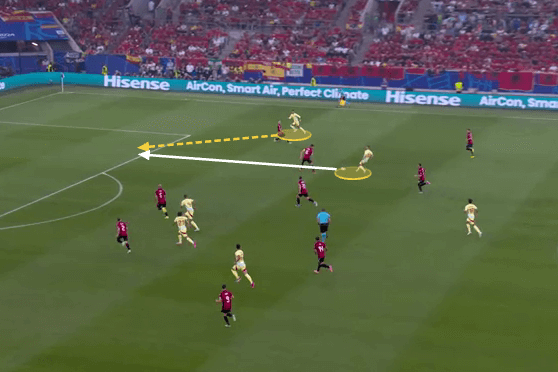The last time Spain won a major tournament, technically speaking, was last year. Their women’s side triumphed in Sydney to win the Women’s World Cup playing a brand of football that was very familiar to the men’s side.
Arguably their key player in the knockout stage was Salma Paralluelo, which was unusual considering she wasn’t actually a regular starter. She was a substitute in the quarter-final and scored the winner. She was again a substitute in the semi-final and again scored the winner. She started up front in the final and didn’t score, but she was a surefire pick for the best XI of the tournament, despite the fact she wasn’t a surefire pick for her own team’s starting XI.
This seems strange but also seems increasingly common. Federico Chiesa, who started only four of Italy’s seven games at the last European Championship, was also voted into the team of the tournament despite being most effective as a substitute. Perhaps, in this era where managers can use five subs, we should also pick a ‘best bench’ of the tournament — not simply players who consistently started but weren’t quite good enough to get in the best XI, but players who made the biggest impact from the bench.
That is likely to be the role of Dani Olmo at Euro 2024. With Spain already qualified for the knockout stage after two hugely impressive wins over Croatia and Italy, Luis de la Fuente rotated almost his whole side for the 1-0 win over Albania in Dusseldorf.

GO DEEPER
Ditching big names, texting staff, familiar faces – how De la Fuente moulded a winning Spain
The only survivor of the convincing 1-0 win over Spain was centre-back Aymeric Laporte, the only player who had come into the side after missing out in the 3-0 win over Croatia in the opening game — and he was replaced at half-time.
Essentially, no one was to start all three games. Only his fellow centre-back Robin Le Normand has played more than 180 minutes so far and everyone bar third-choice goalkeeper Alex Remiro has played some part. Tournament football has always been a squad game, but now it’s a 26-man squad game.
The Spain of 2024 is not the Spain of 2020, or 2016, and certainly not of 2012. Tiki-taka hasn’t entirely been overhauled — there’s still the technical quality and the basic principles of that style of football — but Spain’s first XI for this tournament features a proper centre-forward, Alvaro Morata, and two proper wingers, Nico Williams and Lamine Yamal. No false nine dropping deep and no wide players drifting inside to overload the centre.
So where does Olmo come in? Olmo is a different type of player, more typical of Spain a few years ago. He can drift inside from either flank or play as a false nine, as he did to great effect in the Euro 2020 semi-final, or he can play as an attacking central midfielder, as he did on Monday night. Spain looked like 4-2-3-1 without possession and 4-3-3 in possession. Olmo pressed high, then found space in the right-hand channel.
And at that simple concept of finding space, Olmo is arguably the best player in Spain’s squad. It showed for the only goal of the game. First, right-sided centre-back Daniel Vivian was on the ball. The passing lane to Olmo was blocked.

So he shifted his position a little, drifting right into the channel and asking for the ball into feet. The pass didn’t come and instead went across the defence to Laporte.

Olmo took that as a sign to sprint diagonally forward, again putting himself in a position to receive the pass.

Laporte was more ambitious than Vivian and fired the ball into Olmo’s feet.

Olmo had the ball between the lines. This type of movement is simple on paper but more difficult in the middle of a high-tempo, top-level football game. Olmo understands space and angles better than almost anyone in football at the moment — and then came the assist for Ferran Torres.

That was something the two had planned.
“I had spoken with Dani before the game, for him to measure those balls into space,” said Torres. “When I made the run, I knew he’d seen me and I didn’t think twice.” The finish, in off the far post, was perfect.

It was a classic Spanish-style goal, perhaps most reminiscent of the balls Lionel Messi used to play for Pedro at Barcelona. That comparison flatters Olmo, of course, but he wears No 10 for Spain and, just like Messi, who was an outsider at Barcelona initially as he’d grown up in Argentina, Olmo feels like he offers something different, in part because his formative years were spent with Dinamo Zagreb, a club who worship No 10s, whereas Spaniards tend to prefer deep passers and drifting playmakers from wide.
There was much more to Olmo’s game. He repeatedly tried similar passes for Torres. He twice collected fierce cutbacks from the full-backs, Jesus Navas and Alex Grimaldo, with excellent first touches. At the start of the second half, he attempted a shot from the halfway line, which he skewed wide, but it shows his level of confidence.
“Dani Olmo is a superb player; a fantastic footballer. I really value him,” said De la Fuente afterwards.
“He’s a team player. He stands out, but he thinks about the team more than himself as an individual. I have so many different players to choose from, so many solutions, and that’s great for the national side.”
Olmo might not force his way into Spain’s starting XI, despite his brilliance on Wednesday night, but, as recent history shows, that doesn’t mean he can’t be the tournament’s most decisive attacker.

